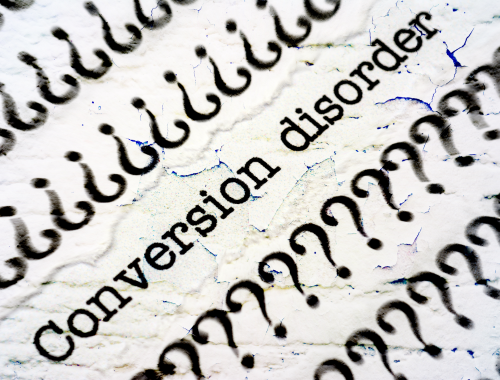Difference Between Conversion Disorder and Somatization
Somatization disorder is the presence of persistent symptoms for more than 6 months, that are unrelated to any disease. Conversion disorder is a mental health disorder in which physical symptoms occur due to mental health issues and not due to any brain-related diseases.

What is a conversion disorder?
Definition:
Conversion disorder is a mental health disorder in which physical symptoms occur due to mental health issues and not due to any brain-related diseases.
Symptoms:
Symptoms of conversion disorder include psychogenic nonepileptic seizures, distorted sensations like visual problems, reduced hearing, altered taste, numbness or tingling, pain in different body parts, muscle spasms and twitches, dysphagia, lightheadedness, and intense fatigue.
Causes:
The exact cause of conversion disorder is yet to be known however certain reasons are linked with the condition. These include a history of childhood abuse, anxiety or depression, a recent traumatic event, or a health condition.
Diagnosis:
Several physical, and neurological examinations and investigations are required to diagnose conversion disorder. The disorder will be confirmed once the symptoms are deemed unrelated to any medical condition, the symptoms are brain-related and are affecting the activities of daily living.
Treatment:
Treatment of conversion disorder is through medications, physical therapy, and psychotherapy such as cognitive behavioral therapy, hypnotherapy, and support groups.

What is somatization disorder?
Definition:
Somatization disorder is the presence of persistent symptoms for more than 6 months, that are unrelated to any particular disease.
Symptoms:
Pain, fatigue, tiredness, decreased appetite, and gastrointestinal problems are the most common symptoms presented by patients with somatization disorder. No matter how severe these symptoms are, a medical cause cannot be identified.
Causes:
Chronic stress, anxiety, and depression are linked with somatization disorder.
Diagnosis:
Multiple examinations are required to rule out and exclude other diseases to get the diagnosis of somatization disorder.
Treatment:
Symptomatic treatment is given to patients with somatization disorder; however it works best with psychotherapy as stress is the leading cause of the condition.
Difference between conversion disorder and somatization
Definition:
Conversion disorder is a mental health disorder in which physical symptoms occur due to mental health issues and not due to any brain-related diseases. Somatization disorder is the presence of persistent symptoms for more than 6 months, that are unrelated to any disease.
Symptoms:
Symptoms of conversion disorder include psychogenic nonepileptic seizures, distorted sensations like visual problems, reduced hearing, altered taste, numbness or tingling, pain in different body parts, muscle spasms and twitches, dysphagia, lightheadedness, and intense fatigue. Pain, fatigue, tiredness, decreased appetite, and gastrointestinal problems are the most common symptoms presented by patients with somatization disorder. No matter how severe these symptoms are, a medical cause cannot be identified.
Causes:
The exact cause of conversion disorder is yet to be known however certain reasons are linked with the condition. These include a history of childhood abuse, anxiety or depression, a recent traumatic event, or a health condition.
Chronic stress, anxiety, and depression are linked with somatization disorder.
Diagnosis:
Several physical, and neurological examinations and investigations are required to diagnose conversion disorder. The disorder will be confirmed once the symptoms are deemed unrelated to any medical condition, the symptoms are brain-related and are affecting the activities of daily living.
Multiple examinations are required to rule out and exclude other diseases to get the diagnosis of somatization disorder.
Treatment:
Treatment of conversion disorder is through medications, physical therapy, and psychotherapy such as cognitive behavioral therapy, hypnotherapy, and support groups. Symptomatic treatment is given to patients with somatization disorder; however, it works best with psychotherapy as stress is the leading cause of the condition.
Table of differences between conversion disorder and somatization

FAQs
Is somatization associated with conversion disorder?
Conversion disorder is a specific type of somatization involving the central nervous system.
What can be mistaken for conversion disorder?
Neurologic diseases can be mistaken for conversion disorders.
What are the 4 types of conversion disorder?
4 types of conversion disorders are motor deficits, sensory symptoms, pseudo seizures, and with mixed symptoms.
What is the hallmark of conversion disorder?
Conversion disorder is a mental health disorder in which physical symptoms occur due to mental health issues and not due to any brain-related diseases.
What is conversion disorder most commonly triggered by?
Conversion disorder is triggered by a traumatic event or mental health disorder.
- Differences Between Reptiles and Amphibians - May 17, 2024
- Difference Between Ophthalmology and Optometry - May 15, 2024
- Difference Between Fear and Anxiety - April 2, 2024
Search DifferenceBetween.net :
Leave a Response
References :
[0]Mai, François. "Somatization disorder: a practical review." The Canadian Journal of Psychiatry 49.10 (2004): 652-662.
[1]Silber, Tomas Jose. "Somatization disorders." Pediatr Rev 32.2 (2011): 57.
[2]Feinstein, Anthony. "Conversion disorder: advances in our understanding." CMAJ 183.8 (2011): 915-920.
